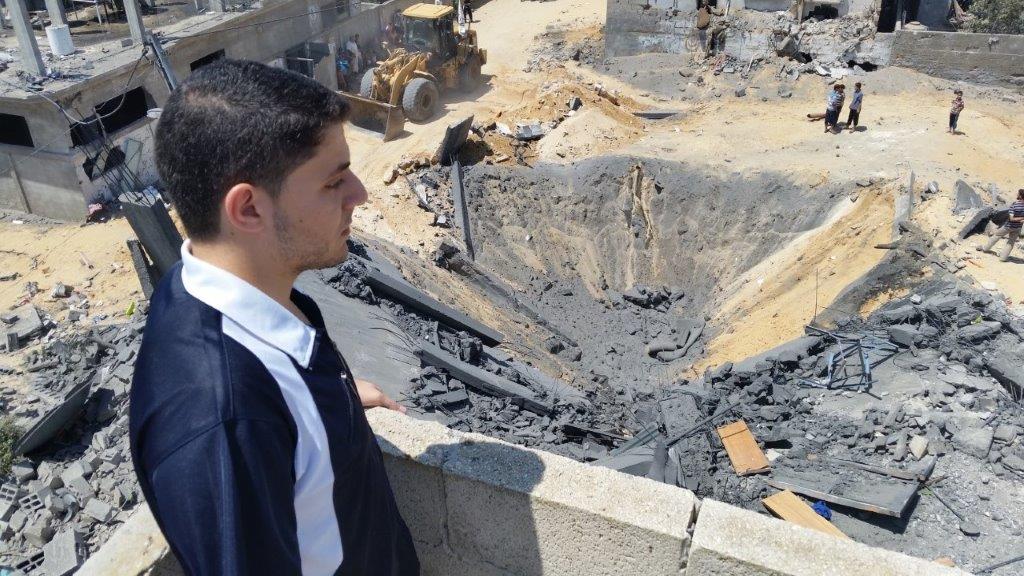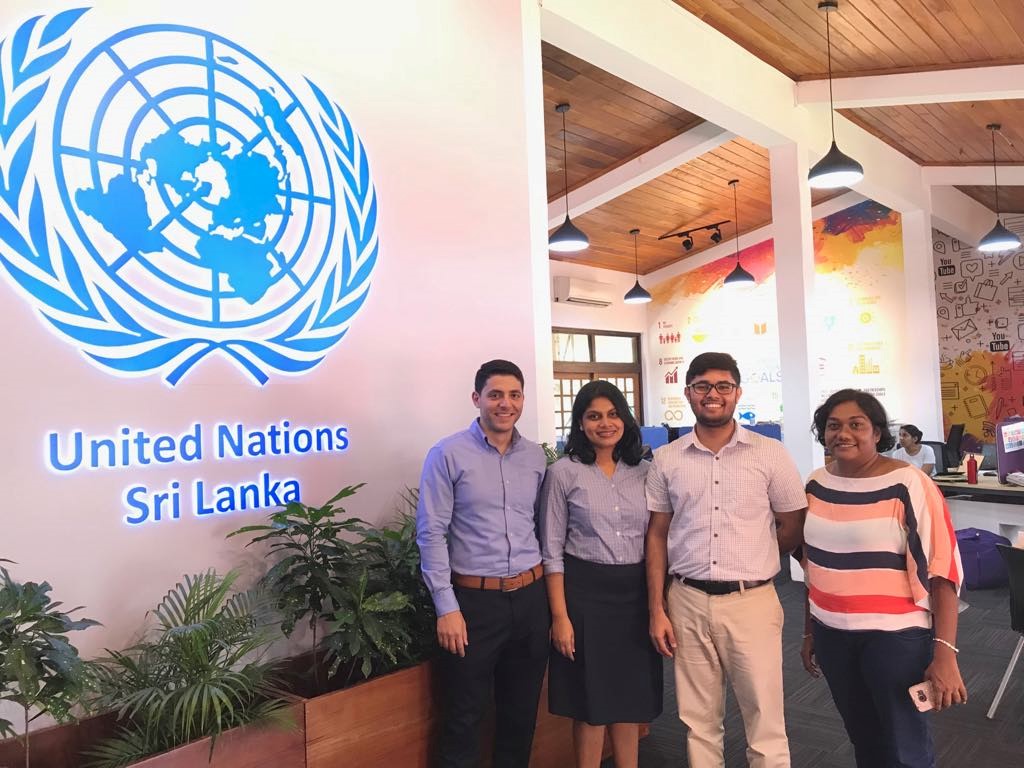From Gaza Strip to Sarajevo passing through Sri Lanka: Conflict Zones and Post Conflict Transition
Just ten months ago, I was spending every morning waking up to one of the worst and most protracted conflicts in modern history. For almost seventy years, Palestine has been subject to hundreds of military offensives. The number of people killed and injured is in the hundreds of thousands. Thousands more are imprisoned and hundreds fall down every month. The continuity and intensity of the conflict render even the most seasoned politicians and experts helpless to find a way out of this crisis. Growing up in this context, it was challenging to remain positive and optimistic. I would read about conflict resolution, but could never imagine it was possible on the ground – not while we were losing our homes and family members every day.
 Mohammed Eid’s house destroyed after an IDF aerial attack on the Rafah Refugee camp prior to my departure to attend the University of North Carolina in 2017.
Mohammed Eid’s house destroyed after an IDF aerial attack on the Rafah Refugee camp prior to my departure to attend the University of North Carolina in 2017.
Now, on the other side of the world, I have just finished my first year in the Global Studies department at the University of North Carolina, located in the United States. Due to the generous support from Rotary International, I am spending my summer interning with the United Nations Development Programme (UNDP) Peace Building mission in Sri Lanka and attending the Sarajevo Post Conflict Transition Symposium in Bosnia and Herzegovina.
Before landing in Sri Lanka in early June 2018, I had performed extensive research about the country and about the work that I would be doing. Stemming from my previous experience in risk assessment and emergency response, I could not avoid worrying about the fact that I would be working in a place torn by ethnic civil war for 26 years (1). The years of colonization and the empowerment of minority groups and the marginalization of majority groups have torn the country’s social fabric and destabilized it politically and economically (2). The civil war started in 1983 when the Liberation Tigers of Tamil Eelam (LTTE) began an armed insurgency demanding an independent Tamil State and ended in 2009 after the Sri Lankan army launched a crackdown on LTTE (3). Soon after the end of the civil war, the UN Security General established the Peace Building Fund (PBF) as part of the UN commitment to support peace building all over the world. The major aim of the PBF is to prevent a relapse into violence and to provide support for victims of war. In 2016, the government of Sri Lanka, the UN, civil society and development partners came together to finalize the Peace Building Priority Plan (PPP), identifying four key areas; transitional justice, reconciliation, good governance, and resettlement and durable solutions. During my internship period, I had the opportunity to join the United Nations Development Program (UNDP) Peace Building Team, which supervised, evaluated and assessed the implementation of the transitional justice plan.
 The Peacebuilding team at the office of the Resident Coordinator in Colombo, Sri Lanka. From the right: Dushanthi Fernando (Program Coordination Specialist) Tharinda De Silva (Peacebuilding Assistant) Niroshini Fernando (Communications Officer) Mohammed Eid (Rotary Peace Fellow).
The Peacebuilding team at the office of the Resident Coordinator in Colombo, Sri Lanka. From the right: Dushanthi Fernando (Program Coordination Specialist) Tharinda De Silva (Peacebuilding Assistant) Niroshini Fernando (Communications Officer) Mohammed Eid (Rotary Peace Fellow).
During my internship period, I had the valuable chance of meeting government officials, attending high-level meetings, listening to beneficiaries at the grassroots level and reviewing and assessing peace building projects. It was a deeply inspiring opportunity to experience the positive transition of a post-conflict zone. The data provided by international organizations like the World Bank and the Organization for Economic Co-operation and Development (OECD), show promising growth of the Gross Domestic Product (GDP), especially during the years after the civil war.
 World Bank and OECD National Accounts data on Sri Lanka GDP (1960 – 2017) (8)
World Bank and OECD National Accounts data on Sri Lanka GDP (1960 – 2017) (8)
Still, the aftermath of a civil war is affecting the Sri Lankans’ daily life, as indicated by the data and warnings reported by civil society organizations. A post-conflict transition is a complicated and critical process based on four pillars, truth, justice, reparation and non-recurrence. Almost ten years after the end of this civil war, the affected communities still demand information on their lost family members (4). During my work with the Peace Building Mission, I came to understand that Sri Lanka is a country with the world’s second highest number of disappearances, with over half a million missing persons. Considering the geographical nature of Sri Lanka, with its spread of rainforests and seasonal rainfall, the process of searching for and identifying war victims becomes a huge challenge. While the government is collaborating with different partners and organizations, the efforts do not match up with the scale of the crisis. The risk of this crisis lies in the fact that their families remain in a state of unrest, anxiety and instability, which could undermine the peace process.
To understand the culture, context and to interact with the local population, I traveled around the country, visiting religious sites and observing different spiritual practices that have helped this society to overcome its trauma and build up resilience. I found the Sri Lankan society to be full of peacefulness, generosity, kindness and hospitality. I have visited poor communities in other mountainous areas and surprisingly observed how the people offer their food to the visitors, how they share the little they have with even the animals that live around them, even with stray dogs. I was deeply convinced that violence is not rooted in our human race, it’s rather peace, love and respect, and in order to establish peace, we should address behavioral and cultural problems on the individual level.
 A young boy sitting by a religious site offering food and water to travelers. Photo by Mohammed Eid.
A young boy sitting by a religious site offering food and water to travelers. Photo by Mohammed Eid.
In mid-July, I flew to Bosnia and Herzegovina to attend the Sarajevo Symposium on Post-Conflict Transitions. Sarajevo itself is described by academics as a big laboratory for post-conflict transition. It has been through a four-year siege between 1992 and 1996 after the country declared independence from former Yugoslavia. Soon after declaring independence in 1992, the Army of Republic of Srpska, along with Bosnian Serbs, held positions inside Sarajevo and over the surrounding hills (5). Unexpectedly, food, medicine, water, electricity and heating fuel were cut off from the city. Daily shelling and sniper attacks terrorized the city with an average of 300 shells targeting the city every day. The siege resulted in over 97,000 deaths and hundreds of thousands of missing persons (6). Over 2 million people were forced to leave their homes and genocides were committed in Srebrenica. The International Court of Justice (ICJ) dealt with evidence of crimes against humanity, widespread killings, siege of towns, mass rapes, torture, deportation to camps and detention centers, which was judged as war crimes (7).
As I am learning about the Siege of Sarajevo, I could not help but think of my own family. My parents and five siblings remain in Gaza Strip, in even worse conditions. For me, understanding conflict and post-conflict transition cannot get more personal. I continue thinking of them as I attend classes and seminars. Although the symposium theme focuses on topics related to community reconciliation and post-conflict reconstruction for peace, I continue searching and inquiring about intervention strategies during active conflicts. The guest speakers have different backgrounds ranging from former presidents, state ambassadors, UN senior representatives and distinguished academics, allowing me to discuss and enrich my understanding of the transition process and the role of international peacekeeping missions. Unfortunately, it is a fact that international intervention is only permitted during active genocide against civilians, mostly during times when it is too late to prevent a crisis. Such a flaw in the international intervention policy calls for a considerate revision and reform of the policy to better address rising challenges.
This rich summer experience has equipped me with more knowledge of conflict and post-conflict transitions. I found that an effective international intervention should consider a readjustment in strategies of interventions and implement multidimensional mandates that allow the peacekeeping mission to practice necessary measurements to prevent civilian mass killings, ensure supply of medicine and food during a conflict, and at the same time, support peace talks and conflict mediation. Failing to adopt such amendments does not -in its worst impact- only result in civilian causalities, but rather undermines the concept of global peace and rule of law, leading to political frustration and the fall of global governing systems.
Thank you
I find myself speechless in trying to choose the proper words to thank those who enabled me to be here. I thank Rotary International for awarding me a Rotary Peace Fellowship, I thank the Duke-UNC Rotary Peace Center for all the support and help they have given to me. I thank the DC Rotary Club for sponsoring my participation in the Sarajevo Symposium. I thank every single Rotarian around the globe, whom their involvement with Rotary makes such opportunities possible. Your act of kindness will never be forgotten.
Mohammed Eid
Rafah Refugee Camp, Gaza Strip
Palestine
1. “LTTE defeated; Sri Lanka liberated from terror”. Ministry of Defence. 18 May 2009. Retrieved 18 June 2018.
2. Sherman, Jake (2003). The Political Economy of Armed Conflict: Beyond Greed and Grievance. New York: Lynne Rienner Publishers. p. 198. ISBN 978-1-58826-172-4.
3. “Taming the Tamil Tigers”. Federal Bureau of Investigation. Federal Bureau of Investigation. (2008). Retrieved 17 June 2018.
4. From correspondents in Colombo (17 May 2009). “Tamil Tigers admit defeat in civil war after 37-year battle”. News.com.au. Retrieved 17 June 2018.
5. Hartmann, Florence (2007). “A statement at the seventh biennial meeting of the International Association of Genocide Scholars”. Helsinki. Retrieved 20 June 2018.
6. Bassiouni, Cherif (1994). “Final report of the United Nations Commission of Experts established pursuant to security council resolution 780”. United Nations. Retrieved 21 June 2018.
7. Staff. Momcilo Krajisnik convicted of crimes against humanity, acquitted of genocide and complicity in genocide, A press release by the ICTY in The Hague.
8. The World bank. Country Economy Report, Sri Lanka. https://data.worldbank.org/indicator/NY.GDP.MKTP.CD?locations=LK. Retrieved on: 05 June 2018.